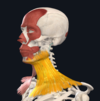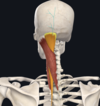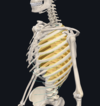muscle charts (head/neck/thorax) COPY COPY Flashcards
1
Q
rectus capitis posterior major
A
- attachments: spinous process C2 > lateral aspect inferior nuchal line
- function: extension, ipsilateral rotation
- innervation: suboccipital n.

2
Q
rectus capitis posterior minor
A
- attachments: tubercle on posterior arch C1 > medial aspect inferior nuchal line
- function: extension
- innervation: suboccipital n.

3
Q
obliquus capitis inferior (inferior oblique)
A
- attachments: spinous process C2 > transverse process C1
- function: ipsilateral rotation
- innervation: suboccipital n.

4
Q
obliquus capitis superior (superior oblique)
A
- attachments: transverse process C1 > area between superior and inferior nuchal lines on occipital bone
- function: extension, lateral flexion
- innervation: suboccipital n.

5
Q
anterior digastric
A
- attachments: digastric foss of mandible > intermediate tendon
- greater cornu of hyoid, inferior border of mandible near sumphysis > intermediate tendon and body and cornu of hyoid
- action: depression of mandible, elevation of hyoid
- innervation: mylohyoid branch of inferior alveolar n. (from CN V3)
- suprahyoid

6
Q
posterior digastric
A
- attachments: temporal mastoid notch > intermediate tendon
- greater cornu of hyoid, mastoid process > intermediate tenon and body and cornu of hyoid
- action: depression of mandible, elevation of hyoid
- innervation: facial n. (CN VII)
- suprahyoid

7
Q
geniohyoid
A
- attachments: inferior genial tubercle of mandible > anterior aspect of body of hyoid
- median ridge of mandible > body of hyoid
- action: elevation of tongue and hyoid, depression of mandible
- innervatoin: ventral ramus of C1 via CN XII
- suprahyoid

8
Q
longus capitis
A
- attachments: anterior tubercle of transverse processes of cervical vertebrae > basilar occipital bone
- action: flexion of head and neck (bilateral), ipsilateral rotation (unilateral)
- innervation: ventral rami of cervical spinal n. (C1-3)

9
Q
longus colli (L. neck)
A
- attachments: cervical vertebral bodies > cervical vertebral bodies and transverse processes
- actoin: flexion/lateral flexion of neck, ipsilateral rotation
- innervation: ventral rami of cervical spinal n. (C2-7)

10
Q
mylohyoid
A
- attachments: mylohyoid line of mandible > midline rache and anterior aspect of hyoid
- function: elevation of floor of oral cavity
- innervation: mylohyoid branch of inferior alveolar n. (from CN V3)
- suprahyoid

11
Q
omohyoid (G. omos, shoulder)
A
- attachments: superior border of scapula medial to scapular notch > lateral aspect of hyoid, passing through intermediate tendon sling loosely associated with clavicle and first rib
- actions: depression of hyoid
- innervation: ansa cervicalis (C1-3)
- infrahyoid

12
Q
anterior scalene
A
- attachments: anterior tubercles of middle cervical vertebrae > scalene tubercle of 1st rib
- action: elevation of first rib in forced inspiration, flexion/lateral flexion/contralateral rotation of neck
- innervation: lower ventral rami of cervical spinal n.

13
Q
middle scalene
A
- attachments: transverse processes of cervical vertebrae > first rib
- action: elevation of first rib in forced inspiration, lateral flexion/contralateral rotation of neck
- innervation: lower ventral rami of cervical spinal n.

14
Q
posterior scalene
A
- attachments: lower cervical transverse processes > 2nd rib
- action: elevation of rib in forced inspiration, lateral flexion/contralateral rotation of neck
- innervation: ventral rami of cervical spinal n. (C6-8)

15
Q
sternocleidomastoid
A
- attachments: lateral aspect of mastoid process, superior nuchal line > manubrium, medial 2/3 of clavicle
- action: flexion/ipsilateral lateral flexion/extension of head and neck, contralateral rotation of head
- innervation: accessory n. (CN XI), C1-2

16
Q
sternohyoid
A
- attachments: posterior side of proximal clavicle, adjacent manubrium > inferior border of body of hyoid
- action: depresses hyoid
- innervation: ansa cervicalis (C1-3)
- infrahyoid

17
Q
sternothyroid
A
- attachments: posterior aspect of manubrium, costal cartilage of first rib > thyroid lamina
- action: depression of elevated larynx
- innervation: ansa cervicalis (C1-3)
- infrahyoid

18
Q
stylohyoid
A
- attachments: styloid process of temporal bone > greater cornu of hyoid bone
- action: elevation/retraction of hyoid
- innervation: facial n. (CN VII)
- suprahyoid

19
Q
thyrohyoid
A
- attachments: thyroid lamina > greater horn of hyoid bone
- actions: depresses hyoid, elevation of thyroid cartilage
- innervation: ventral ramus of C1 via XII
- infrahyoid

20
Q
buccinator (L. bucca, cheek)
A
- attachments: alveolar processes of maxilla and mandible, pterygoid hamulus and pterygomandibular raphe > angle of mouth
- action: compresses cheek
- innervation: buccal branch of facial n.

21
Q
depressor anguli oris
A
- attachments: mandible > angle of mouth
- action: depresses buccal angle laterally
- innervation: buccal and mandibular branch of facial n.

22
Q
frontalis
A
- attachments: superficial fascia of eyebrows > epicranial aponeurosis
- actions: protracts scalps, elevates eyebrows and nose
- innervation: temporal branch of facial n.

23
Q
levator labii superioris
A
- attachments: inferior orbital margin > lateral aspect of upper lip
- action: raises and everts upper lip
- innervation: buccal and zygomatic branches of facial n.

24
Q
nasalis
A
- attachments: maxilla (lateral and inferior to nasal notch) > bridge and ala of nose
- action: transverse fibers compress, alar fibers wide nasal aperature
- innervation: buccal branch of facial n.

25
orbicularis oculi
* attachments: orbital margin and medial palpebral ligament \> superficial fascia of eyelid
* action: palpebral sphincter (closes eyes)
* innervation: temporal and zygomatic branches of facial n.

26
orbicularis oris
* attachments: angle of mouth \> superficial fascia of upper lip
* action: oral sphincter (closes mouth)
* innervation: buccal and mandibular branches of facial n.

27
platysma (G. platys, flat, broad)
* attachments: lower border of mandible \> superficial fascia of skin of neck overlying clavicle
* action: wrinkles anterior nuchal skin
* innervation: cervical branch of facial n.

28
zygomaticus major (G. zygon, yoke, joining or pair)
* attachments: zygomatic bone \> angle of mouth
* action: raises angle of mouth
* innvervation: buccal and zygomatic branches of facial n.

29
inferior oblique
* innervation: inferior ramus of oculomotor n.

30
inferior rectus
* innervation: inferior ramus of oculomotor n.

31
levator palpebrae superioris
* superior ramus of oculomotor n.

32
medial rectus
* innervation: inferior ramus of oculomotor n.

33
superior rectus
* innervation: suprior ramus of oculomotor n.

34
lateral rectus
* innervation: abducens n.

35
superior oblique
* innervation: trochlear n.

36
masseter
* attachments: zygomatic arch \> angle of mandible, lateral aspect of ramus
* action: elevation, protraction, retraction (deep fibers) of mandible
* innervatoin: mandibular nerve (from trigeminal n.)

37
temporalis
* attachments: temporal fossa \> coronoid process, anterior border of ramus of mandible
* action: elevation and retraction (posterior aspect of muscle) of mandible
* innervation: mandibular nerve (from trigeminal n.)

38
lateral pterygoid
* attachments: infratemporal surface of spheroid, lateral surface of terygoid plate \> neck of mandible, TMJ disc
* action: depresses mandible, protracts and acts with ipsilateral medial pterygoid to rotate mandible to roduce side-to-side movements in chewing
* innervation: mandibular nerve (V3)

39
medial pterygoid
* attachments: medial surface of lateral pterygoid plate, adjacent maxilla \> medial aspect of angle of mandible
* action: elevation of mandible, acts with ipsilateral pterygoid to rotate mandible for side-to-side movements of food
* innervation: mandibular nerve (from trigeminal n.)

40
splenius capitis (G. splenion, bandage)
* attachments: ligamentum nuchae, lower cervical and upper thoracic spinous processes \> lateral third of superior nuchal line
* action: extension, lateral flexion, ipsilateral rotation of head
* innervation: dorsal rami of cervical spinal n.

41
longissimus capitis
* attachments: upper thoracic transverse processes \> posterior margin of mastoid process
* action: extension, lateral flexion, ipsilateral rotation of head
* innervation: dorsal rami of spinal n.

42
semispinalis capitis
* attachments: upper thoracic and cervical spinous processes \> occipital bone between inferior and superior nuchal lines
* actions: extension, contralateral rotation of head
* innervation: dorsal rami of cervical spinal n.

43
external intercostal
* attachments: rib \> rib
* oriented from superior-lateral to inferior-medial (down and in)
* action: elevation of ribs
* innervation: intercostal nerve
* segmental

44
internal/innermost intercostal
* attachments: rib \> rib
* oriented from superior-medial to inferior-lateral (down and out)
* action: depression of ribs
* innervation: intercostal n.
* segmental

45
transversus thoracis
* attachments: posterior sternum \> costal cartilages
* action: depression of ribs
* innervation: intercostal nn.
* segmental

46
diaphragm
* attachments: xiphoid process, inner surface of lower ribs, costal cartilages, lumbar vertebrae (crura) \> central tendon
* action: inspiration
* negative thoracic pressure by inferior displacement
* innervation: phrenic nerve
* C3-5



